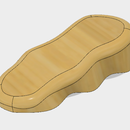Introduction: 3D-printable Rubik's Cube in Fusion 360
Rubik's cubes were invented in 1974 by a man named Ernő Rubik. The design has fascinated millions over the years and more recently myself. I have collected many different kinds of Rubik's cubes but there was one kind of cube I had yet to collect... a 3D printed one. So guess what I went and did... I made one.
Requirements:
A 3D printer
Basic knowledge of Fusion 360 Design
LAYOUT:
A Rubik's cube (all versions before roughly 2016) were made of only four components.
1. The "heart"- six cylinder edges smashed together in a spoke-like fashion
2. The center pieces- six flat pieces that connect directly to the heart and have one face
3. Edge pieces- 12 edges that sit directly next to the center pieces and have 2 faces
4. Corner pieces- 8 Corner pieces that sit diagonal to the center pieces and have 3 faces
Step 1: The "heart"
I like to call this piece the heart because without it, there would be no functional cube. It connects to all of the center pieces and allows them to spin.
To begin: create a new component and start a new sketch on the base XZ plane. Draw an 8mm circle from the origin and extrude it 9.5mm symmetrically.
Next we want to create an axis through the center of the cylinder so go to Construct -> Axis through Cylinder and then click on the revolving wall.
Now we will create an offset plane that we want tangent to the cylinder. You could use the "tangent plane" feature but I decided to use a normal offset plane. Make make sure the origin is visible and click on the YZ plane and offset it 4mm.
Create a sketch on this new offset plane and draw a 8mm diameter circle. You can use the origin as the starting point if you extruded symmetrically in the first step. If not click on the axis that runs through the cylinder and center it vertically.
Extrude this circle and in the options under "Direction" change it to "two sides". Side one should be "Distance" and 5.5 mm. Side two should be "to Object". Select the cylinder and it should merge to it. Min solution and Chain faces should be selected.
Now create a circular pattern. Change the pattern type to "feature" and click on the extrusion that we just made in the timeline on the bottom of the screen. Select the axis running through the cylinder that we created and change the quantity to four.
Create a sketch on one of the circular end faces and a draw a 5mm center circle. Using that as the sketch, cut into the cylinder 4mm.
Create another sketch on the same face but this time make a 6mm circle. We are going to create another cut with the sliver of the circle that is around the already cut circle. In the options, change the start position to offset plane and set it inward 1.75mm (it might be negative depending on what face you picked). Set the distance inward to 2.25.
Create a new circular pattern with feature as the type. Select the two cuts that we just made as the objects and select one of the perpendicular cylinder faces as the axis. Change the quantity to 4.
Repeat this process again selecting the other perpendicular cylinder face as the axis this time.
The last step to finish the heart is to create chamfers on the inner edges of each cylinder face. Set the distance to .75mm.
The "heart" of the cube is complete and we can move onto the side centers!
Step 2: The Side Centers
Start by creating a new component and a new sketch.
Draw a 19x19mm square and extrude it 11mm.
Create a sketch on one of the sides and connect two of the same longer side corners with an arc that has a diameter of 16.5mm. Stop the sketch.
On the larger face that is connected to the two corners you just used, start a new sketch.
Place a point in the very center and stop the sketch again.
Create a loft between these two sketches and use the cut operation.
With the origin of this component visible, create a circular pattern using the lofted cut we just made as the feature. Select the Z axis and change the quantity to 4.
Create a new sketch on the bottom face that all of the lofted cuts are made on. To do this, go to the browser and make the last sketch visible and select the point you made that was used in the cuts. Draw an 8mm diameter circle from the center.
Extrude this sketch and select the "Two side" option. Side 1 will simply be 8mm. For side 2, change extent to "to object" and select the far side square face. Make sure chain faces is selected and that the operation is a join.
Fillet all of the corners except for the extruded cylinder. I found that 1mm seemed to work quite nicely.
On the circular face at the end of the cylinder, create a new sketch and draw a 3.75 mm circle. Extrude it 3.5mm.
Create an offset plane from this new extrusion and bring it back 1.75mm toward the body.
Create a sketch on this offset plane and draw a centered circle with a 5.75mm diameter. Stop the sketch.
Create a loft between this newly made sketch and the end of the cylinder extrusion.
Start a sketch on any plane perpendicular to the lofted extrusion and draw out a triangular wedge that intersects the flat part of the bigger cylinder body (check the pictures for reference). Make a cut that goes fully through.
The Side Center is now complete and we can work on the Edge piece.
Step 3: The Edges
Create a new component, start a new sketch, and draw a 19x19mm square. Proceed to extrude it out 19mm.
Select a side and use the shell command (modify -> shell). Set the inside thickness to 1.5mm.
Create a sketch on an adjacent side to the one that the shell was just created on. Draw an arc from the side with the opening to a perpendicular edge. The outer side of the arc points should be 11mm away from the corners. Check the pictures to see what it should look like. Cut this sketch through fully to the other side.
Using the same face as the base point, create an offset plane 9.5mm into the center of the cube.
On that offset plane create a sketch and draw an L sort of shape. All of the dimensions for this sketch are included in a picture since its quite difficult to put into works. Once drawn, extrude it 3.5mm symmetrically.
Create another shell on the newly formed top face with a 1mm inside thickness.
Finish the piece off with fillets. You can play around with sizes as long as the outsides of the main squares are 1mm to match the other pieces.
With the edge piece completed, we move onto the Corner!
Step 4: The Corners
The corner piece starts out the exact same as the last piece.
Create a new component, start a sketch, and draw a 19 by 19mm square. Extrude it by 19mm.
Select a face and create an offset plane that extends inward by 1mm.
Create a sketch on this plane and refer to the picture I attached as for what to draw. Essentially it is a diagonally offset square with the inner corner cut off.
Extrude this sketch upward away from the cube by 6.5 mm.
Select the offset plane that was just made and create a new offset plane that reaches 6mm into the cube.
I have attached another picture of the sketch that needs to be drawn on this plane. This one is just an diagonally offset square.
Stop the sketch.
Create a loft between this most recent sketch to the closest face of the extrusion that was just created (the fist sketch plane that has the diagonal square that had a corner cut off).
Create a shell from the furthest face from the cube (the top offset square with the diagonal notch cut out). Set the inside thickness to 1.5mm.
Add fillets to round off edges using 1mm for the outer 19mm squares.
That wraps up the corner piece and therefore all of the pieces needed to build a Rubik's Cube!
Step 5: Assemble and Print!
Assemble/Appearance
If you would like to assemble the cube in Fusion, you'll need to copy and paste each component into the design one by one until the respective component has the correct number of pieces.
You then will need to create quite a few joints to put each piece together. Start with grounding the "heart" then attach the side centers to that. Next add on the edge pieces and save the corners for last.
To change the look of the cubes, press the A key to bring up the appearance window. You can color them by component or face!
Fusion 360 makes printing designs incredibly easy.
Go to the toolbar and click on the "make" button, in the dropdown menu click on "3D print".
Click on the component that you'd like to print and then you have two options. If you check "Send to 3D Print Utility", it will allow you to directly send it to Cura (or whichever your favorite slicing software is). If you do not select this, it will allow you to save the object as an stl file to later import into a printing utility.
And there you have it! Thanks for stopping by! Be sure to leave any suggestions or questions as tweaks will surely be made in the future!

Participated in the
Makerspace Contest 2017

Participated in the
First Time Author Contest













